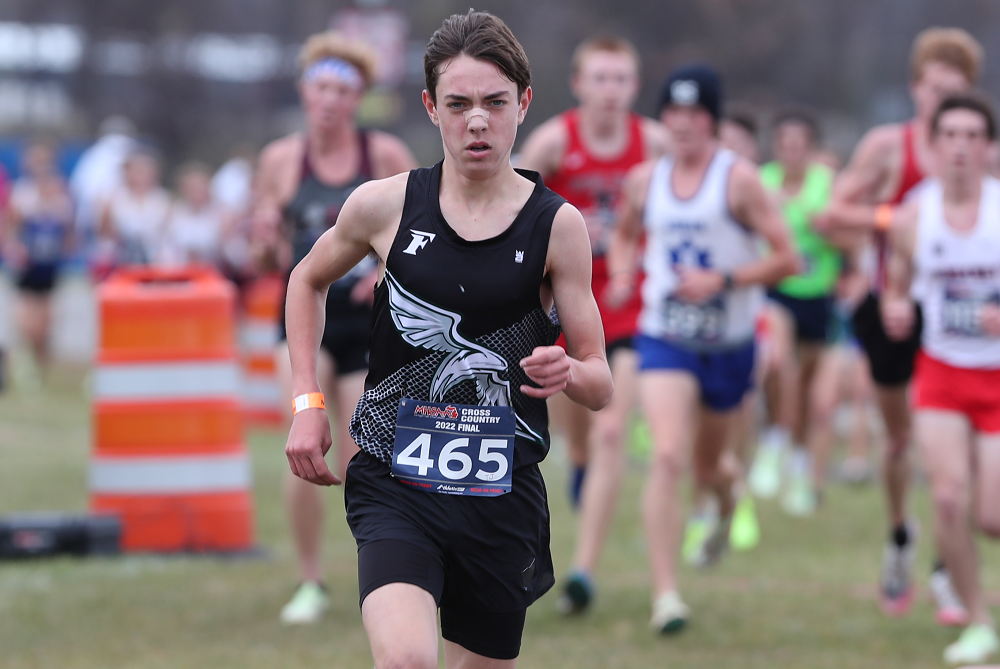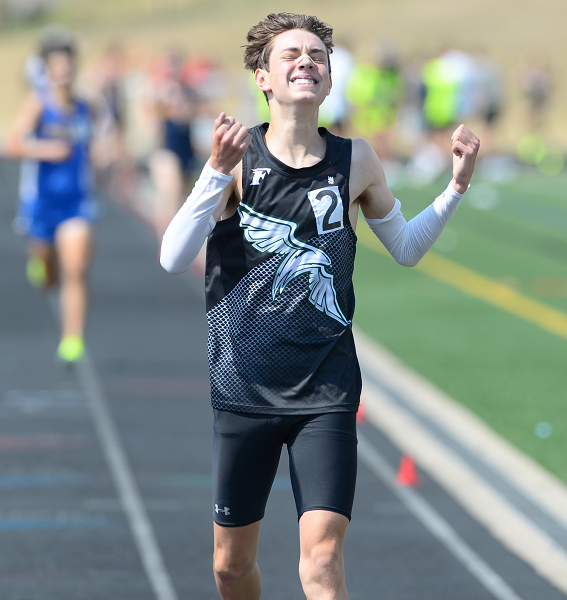
Benzie Freshman, Hanover-Horton Reign
November 2, 2019
Second Half reports
BROOKLYN – It’s been 26 years since a ninth-grader from a high school in the northwest portion of Michigan’s Lower Peninsula made MHSAA cross country history.
Ryan Shay of Central Lake won the 1993 individual race at the Class D championships back when there were separate races for team and individual qualifiers. No freshman boy came close to duplicating Shay’s feat in the quarter century that followed.
But along came Hunter Jones.
Jones joined Shay as the only freshman boys to win a race at an MHSAA Lower Peninsula Final when he ran away with the Division 3 title in 15:45.0 on Saturday at Michigan International Speedway.
Since the Final was moved to MIS in 1996, the best finishes by freshman boys before Saturday were fifth-place showings by Rockford legend Dathan Ritzenhein in Class A in 1997 and Whitmore Lake’s Zach Carpenter in Division 4 in 2006.
Jones, whose school is 70 miles away from Central Lake, was aware of Shay’s running legacy. Shay went on to win the NCAA 10,000-meter championship for Notre Dame in 2001 and claim five national road race titles. He died while racing in the U.S. Olympic marathon trials in New York on Nov. 3, 2007.
“ That would be pretty awesome to be as good as him,” Jones said.
That would be pretty awesome to be as good as him,” Jones said.
Someday, a young runner may say the same about Jones.
He won 12 of his 13 races this season, taking fourth at the Benzie Central Pete Moss Invite on Aug. 24 behind runners from Division 1 and 2 schools.
His time Saturday ranks second at MIS for a freshman in any division, trailing only a 15:40.9 by Rockford’s Cole Johnson in Division 1 in 2014. Jones broke the Division 3 freshman mark of 16:03.8 set by eventual three-time champion Yami Albrecht of Caro.
Jones ran solo from the outset, winning by 28.9 seconds over Vandercook Lake senior Andrew Frohm. Frohm emerged from a tight battle for second place in 16:13.9. There were only 4.3 seconds between the second and fifth finishers.
“He pulled away,” Frohm said of Jones. “I was more looking at the guys who were second, third. The last 100 meters, I outsprinted the guy that was in second.”
Hanover-Horton won the team championship for the second time in three years, scoring 146 points. Grandville Calvin Christian edged Charlevoix, 183-184, for second place.
Garrett Melling was eighth overall and fifth among team runners in 16:21.3, and Dean Reynolds was 10th overall and sixth among team runners in 16:27.6 to lead Hanover-Horton.
Also scoring for Hanover-Horton were Rogan Melling (62nd, 17:17.0), Andy Swihart (72nd, 17:28.1) and Logan Shepherd (89th, 17:41.8).
PHOTOS: (Top) Benzie Central’s Hunter Jones charges toward the finish of the Division 3 boys race Saturday at MIS. (Middle) Hanover-Horton’s Dean Reynolds (451) leads a pack including Potterville’s Zach Wright. (Photos by Dave McCauley/RunMichigan.com.)

Freeland's Hansen Not Focused on Joining All-Time Greats - But On His Way
By
Paul Costanzo
Special for MHSAA.com
September 29, 2023
The goal written on Matt Kaczor’s Post-It Note was sub-15 minutes, 15 seconds. That’s what the Freeland cross country coach was hoping for from star runner TJ Hansen during his junior season.
 Kaczor tore it up after seeing Hansen run a single race this fall.
Kaczor tore it up after seeing Hansen run a single race this fall.
“Knowing what he did over the summer and where he was at, seeing what his 1,600 (meter) and his mile got down to, I had a feeling he could get under 15:30 quickly,” Kaczor said. “After the first race, I looked at my assistant and was like, ‘I’ve gotta rip up that Post-It Note. I don’t think our goal is on the level of where he’s at right now.’ At first, it was break 15:15. Once I saw him race at the Under the Lights (on Aug. 18 at St. Johns), I was like, ‘Yeah, he’s going sub 15.’”
Hansen ran 15:39.6 in that first race, and on Sept. 7, in Shepherd, he ran 15:13.9 to meet the goal written on the now-shredded Post-It Note.
This past Saturday, he ran 15:03.7 at the Cadillac Veterans Serving Veterans Invitational. It’s the fastest time recorded in Michigan this year, and a signal that Kaczor might be filling out a new Post-It Note before the season is out.
“The sub-15 barrier, that’s been something on my mind for a while,” Hansen said. “Now that I’m edging closer and closer to that, it’s been exciting. With how heavy my training has been, I wouldn’t expect (to have run this fast this early). Being able to run the times I am really paints the picture for what’s ahead.”
Hansen came into the season already regarded as one of the elite distance runners in the state. He won the 3,200 meters at the MHSAA Lower Peninsula Division 2 Track & Field Finals this past spring. He’s also finished all-state (12th and fifth, respectively) the past two seasons at the LPD2 Cross Country Finals.
His current trajectory, however, would put his name near some of the state’s all-time greats. But that’s not something Hansen is focusing on.
“I really don’t like to compare myself to others,” he said. “I don’t focus on that. I try to be the best TJ Hansen that I can be. The best version of myself.”
Focusing on himself is almost necessary for Hansen, as he’s spending a lot of time during his races running by himself.
At each of the big events Freeland has run in this season, Hansen has finished at least 20 seconds ahead of his nearest competitor. That includes all divisions of the Duane Raffin Festival of Races in Holly.
In Cadillac, where Hansen ran his current best time, he was a full minute ahead of the rest of the field.
 “He’s just a special athlete,” Kaczor said. “I can’t see Freeland having someone like this in a while. He’s a generational talent. What’s crazy is, I had the school record when he was a freshman. He and Braden (Honsinger) broke it last year. But TJ has now dropped that school record (set in 1998) by almost a minute.”
“He’s just a special athlete,” Kaczor said. “I can’t see Freeland having someone like this in a while. He’s a generational talent. What’s crazy is, I had the school record when he was a freshman. He and Braden (Honsinger) broke it last year. But TJ has now dropped that school record (set in 1998) by almost a minute.”
Hansen’s achievements have already put him on a path to run at the next level, which is something of a family tradition.
His older sisters Peyton and Kiera are track & field athletes at Wayne State and Eastern Michigan, respectively. Their parents, Tim and Pam, were track & field stars at Central Michigan.
TJ has drawn the attention of coaches around the country, including from Michigan, Michigan State, Wisconsin, Tennessee and Colorado.
Having family members who know the process is a help for Hansen, and he said they’ve all been good about allowing him to choose his own path, whatever that may be.
“He’s from a good family that knows how to work and knows how to get things done,” Kaczor said. “He knows that if he puts in the work, he’s going to be at a good spot.”
While Hansen admits it can be a bit overwhelming, he’s using it as motivation to run faster and continue to put his name out there.
Also serving as motivation is 2022 Division 2 champion Connell Alford of Chelsea. Alford is among the elite group of runners in Michigan who have broken the 15-minute mark, doing it twice a year ago.
He currently has the state’s second-best time behind Hansen’s this year, running 15:09.1 at the MSU Invitational on Sept. 15.
“Whenever I see him drop a time, my main goal is to run faster,” Hansen said. “Whenever I see him run a good time, that motivates me to work hard.”
The two won’t see each other until the MHSAA Finals on Nov. 4 at Michigan International Speedway. It’s an opportunity Hansen is excited for, as it’s a chance to race and be pushed toward the lofty goals he’s set for himself. Kaczor is excited about it, too, even if it might mean having to replenish his supply of Post-Its.
“We don’t talk about winning the state title; we talk about making sure that we have great races on those days,” Kaczor said. “We can’t control how somebody else runs. It’s a matter of can we, if the weather is right and the course is in good condition, can we be one of the few guys that has run in the 14s on that course? That’s the goal. Put yourself in some great categories with those upper echelons and the greats of all-time.”
 Paul Costanzo served as a sportswriter at The Port Huron Times Herald from 2006-15, including three years as lead sportswriter, and prior to that as sports editor at the Hillsdale Daily News from 2005-06. He can be reached at [email protected] with story ideas for Genesee, Lapeer, St. Clair, Sanilac, Huron, Tuscola, Saginaw, Bay, Arenac, Midland and Gladwin counties.
Paul Costanzo served as a sportswriter at The Port Huron Times Herald from 2006-15, including three years as lead sportswriter, and prior to that as sports editor at the Hillsdale Daily News from 2005-06. He can be reached at [email protected] with story ideas for Genesee, Lapeer, St. Clair, Sanilac, Huron, Tuscola, Saginaw, Bay, Arenac, Midland and Gladwin counties.
PHOTOS (Top) Freeland's TJ Hansen leads a pack during last season's LPD2 Final at Michigan International Speedway. (Middle) Hansen enjoys a moment of exhilaration after winning the 3,200 this spring at the LPD2 Finals at Ada Forest Hills Eastern. (Top photo by Carter Sherline/Run Michigan; middle photo by Dave McCauley/Run Michigan.)

